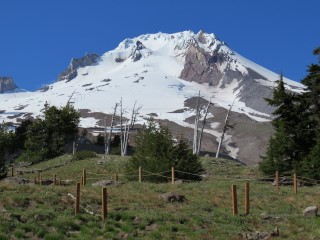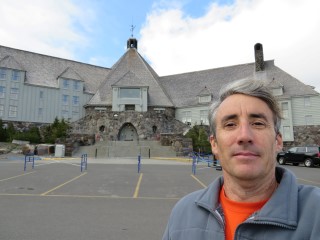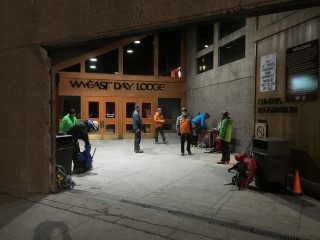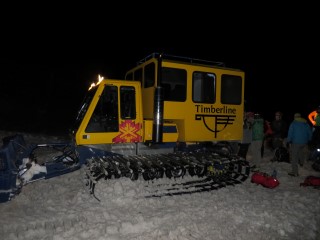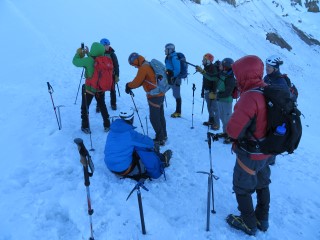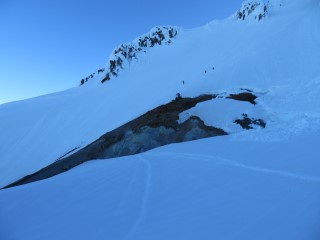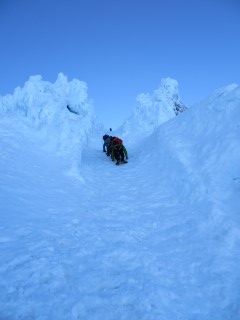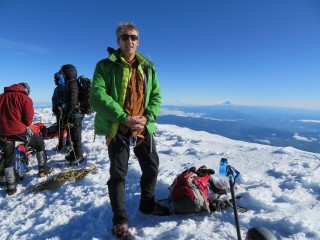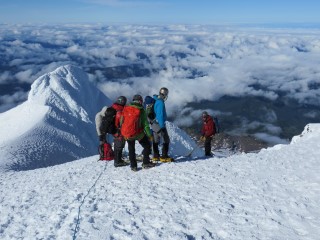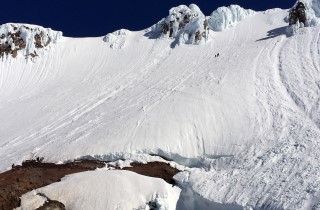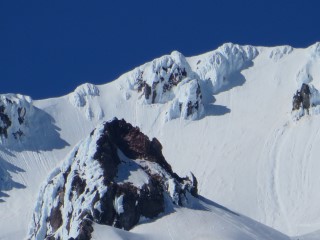Ascending Mount Hood
At 11,249 feet high (varying slightly according to the source), the summit of Mount Hood is the highest point in Oregon. It is an iconic mountain, easily seen from Portland on a clear day. The base of the mountain is reached conveniently by car and includes ski areas and the famed Timberline Lodge. If the lodge looks familiar, that may be because it was used for the exterior shots in the movie The Shining (the interior scenes were done at a movie studio in England).
The climb to the summit of Mount Hood is not long in terms of distance, but it is steep, icy, and fairly dangerous. As of 2012, 130 have died trying to climb it. Nevertheless, about 10,000 people attempt the climb every year (source). On June 4, 2015, I was one of them. According to a sign in the lobby of the Timberline, the distance from the lodge to the summit is only 3.6 miles but with 5,245 feet of elevation gain, which is almost a mile. That is an average slope of 28.7%.
In 2011, I unsuccessfully tried to climb Mount Hood with a group of fellow mountaineers from Las Vegas. About half way up, we called off our attempt since our leader turned back as a result of a previous injury, we were fatigued from climbing Mt. Shasta and other peaks days before, and the conditions were cold and windy. I have felt Mount Hood taunting me for four years. I felt it had defeated me. The feelings only intensified when I returned to the area in the summer of 2014 on a pleasure trip with my family. Come 2015, I decided I was long overdue for a rematch. I trained hard for the few months before to maximize my chances of success.
Previously, I had nagged my Las Vegas climbing friends for years to return to Mount Hood, but talks always broke down between the chatter phase and setting a date. Based on my 2011 attempt, I surmised it would be too dangerous to go it alone, so I booked a trip with Timberline Mountain Guides (TMG). In particular, I booked the two-day Summit Program.
The time finally arrived. At 10:00 AM on June 3, 2015, the day before our summit attempt, we met at the TMG offices to be fitted with any gear we didn't already possess and to go over what to expect. Our group consisted of nine guests and three young, strapping guides. The group was 100% male and ranged in age from about 25 to 60.
After getting our packs in order, we hiked up Mount Hood for about half an hour to a ravine with some steep snow to go over the use of crampons (the spikes one puts on boots for climbing on ice), ice axes, belaying, and short-roped climbing. A lot of this I already knew from previous mountain ascents. This may have worked against me, as I was somewhat set in my self-taught ways, which the guides frequently corrected me on.
On the hike up to the training point, a few of the other guests lagged behind and were very winded when they finally made it. This worried me. I have heard many horror stories of people failing to summit Mount Rainier and other guided climbs due to couch potatoes who ruined the trip by going too slow, being unprepared, or chickening out. The guides have to put safety first and must maintain certain ratios of guests to guides, in this case 3 to 1. In fact, I asked about this before booking the trip and TMG assured me they do what they can to get anybody who wants to summit to the top, while still putting the rules and safety first.
After the training, they told us to try to get some sleep. We were meeting at 1:30 AM the next morning for the summit bid. The reason for leaving so early is the ice loosens in the afternoon sun and there is a greater chance of being hit by large pieces in an avalanche. It wasn't easy to sleep, as I was anxious about the next day, but I think I managed to doze off a little in my room at the Timberline Lodge. Although I set my alarm, I woke up much too early.
With my pack stuffed with all kinds of clothing and gear, much of it I would never touch, I arrived at the rendezvous point well ahead of schedule. At about 2:00 AM, we set out up the mountain to point in a ravine filled with snow near where we trained the day before. We then boarded a Snow Cat to ride up the ski area. This smacked me as cheating somewhat, but the time and energy saved improved everybody's chances of making the summit. Plus, I had gone higher than the drop-off point in my 2011 attempt, so that helped me justify it. For those who may view this as cheating, TMG also offer a two-day overnight trip that includes a full climb up from the lodge. Such a group left just before our training, and they seemed to be a robust and small group of young men, especially compared to our party.
Once the Snow Cat dropped us off, we put on our headlamps, gloves, helmets, and crampons and headed up. Most of us, including me, seemed rip roaring and ready to go. The first few hours were simply a slog up the icy side of the volcano. Although we all used headlamps, the moon was nearly full and provided ample light for this comparatively easy section. As we walked, it sounded like water was flowing beneath the snow. However, I now think it was tiny bits of ice we kicked loose sliding down the side. Either way, this sound of falling water/ice was eerily loud. As I feared the previous day, a couple members of the party on the left side of the bell curve of fitness were not keeping up. We frequently had to take long breaks to allow them to catch up. The goal was to keep the group together. As we waited, there was a lot of grumbling by the other seven guests in the cold. Something had to give. At each point when the last two caught up, the guides went to the side to kibitz but, in the end, they always told us to keep going up without comment.
We pushed up to a fairly level point known as the Devil's Kitchen. It is so-called because of active fumaroles of sulfuric gas. We arrived when it was still mostly dark and stood around in the cold until it was broad daylight as we waited for the two stragglers to catch up. Suffice it to say, some of us in the group were not happy to be standing around in the cold, knowing we had a schedule to keep. On the good side, it was beautifully clear day with hardly any wind.
The Devil's Kitchen was crowded because it was a convenient break point for the other groups heading up. Some had camped nearby and others came along behind us. When our group was finally together, there was more kibitzing by the guides. Finally, after a long wait, they told us to continue upward. I would learn through other guests our guides found another guide going down who took our two stragglers. This was great news as the rest of us were eager to get moving again.
The next section was steeper as we went to the top of Crater Rock. This was the first time we needed to use ice axes to keep from falling. We used them like a cane as opposed to a pick at this point. Behind Crater Rock is a section known as the Hot Rocks, so called for more fumaroles. The guides told us to leave behind our walking poles as we would be relying on our ices axes alone the rest of the way. They then roped us together into three smaller groups. The technique they used is called "short roping," meaning the distance between hikers is short, about five feet. The reason is if one person fell the other two or three would keep him from sliding down. The distance between people is kept to a minimum to prevent the falling person from gaining enough speed to bring down everybody else. The alternative of "long roping" is more appropriate for more level and crevasse-filled climbing.
Our three separate sub-groups made their way up. The first group was fast. The second was much slower. Finally, my group of three was last. Of the three, I was the last on the rope. On our way up, we passed the second group. After rushing up this section, we finally came to the Old Chute. This is the last and steepest section of the climb. The traditional route used to go through the Pearly Gates, to the right, but shifting snow and ice caused that route to fall out of favor. Still, we saw one small party using it.
At this point, there was a traffic jam. It wasn't just our group of 10 but other groups that were waiting for their turn up and down the Old Chute. It was so narrow that only group could go at a time. The way our guides got everyone up was to go up first with a long rope, which we were tied into at the bottom. Once the guide was at the top, he collected the rope as the other guests and I made our way up. This was all done using pickets, belay devices, and carabineers. I was very impressed at how quickly the guides managed to rope together all this mountain climbing gear that I can barely name.
The climb up the Old Chute was very steep. For the first time, I used my ice axe like a pick instead of cane to anchor myself into the ice. Although the risk of falling down was mitigated by the rope, it was still dangerous. Falling ice, evidently kicked loose by previous climbers and loosened by the warning sun, was cascading down the chute like a mini avalanche. Fortunately, the pieces weren't too big, no larger than a walnut. I was also climbing just inches away from Spencer, the guest in front of me. As he moved his feet, his crampons narrowly missed my eyes. In retrospect, this would have been a good time to wear my ski goggles (which I never touched) as opposed to sunglasses. Spencer was of average height, so his crampons never came too close to my eyes. However, in the second team, the guest in the middle was about 6'6" tall and the guest in back was clearly upset about the tall guest's crampon spikes coming within a foot of his eyes multiple times.
With some tempers a bit short, we all made it up the Old Chute safely and with all our eyes still in place. At the top of the chute, other groups waited their turn to get down. Here we left the rope and all its accoutrements behind and made the final, short walk to the summit. This section was a delight compared to what we had just been through. It was glorious to just walk again without the need of ropes or an ice axe. It was steep on both sides, especially the north, but the ridge line itself was a modest upward grade.
A few minutes later, we had reached the summit! In addition to our party, there were other groups there as well. I knew the guides were rushing us, so I didn't have time to let the moment sink in. I had a drink of water and then whipped out my camera for the obligatory summit photos. The views were outstanding. We could easily see Mounts Jefferson, Adams, Rainier, and Saint Helens rising up from above the clouds. The Three Sisters were also visible in the distance. However, there wasn't much time to appreciate the views or contemplate the accomplishment. The guides were anxious to get back, since we were way behind schedule. After 15-20 minutes on top, I was heading back down.
Next, we reached the top of the Old Chute where my group waited for the other two groups in our party to descend as well as other parties of climbers. It was certainly a bottleneck. However, our guide Eliot made good use of the time by burying a picket in the snow to belay Spencer and I down. At this point, my license plate fell out and I got off this quick photo.
Finally, it was our turn to go down the chute. The belay down was fun and easy. At the end of the rope there was a guide from another group preparing his rope and gear for the next section down. When our guide made it down there was what seemed like a confusing mess of ropes and related implements from the two groups. The guides didn't know each other but there seemed be a frostiness between them. Perhaps because this other guide was right in our way. However, he would probably argue the alternative would have put him in right in the path of falling ice from the neighboring chute.
There was indeed a lot of falling ice from the next chute. This time, the pieces were as big as golf balls and, despite all the clothing I was wearing, it hurt a bit when some pieces hit me. Yet another point my ski goggles, which sat totally forgotten in my pack, would have at least made me feel safer. Of all the points in the climb, sitting at the bottom of the chute was probably the most dangerous. As I mentioned, the reason for leaving at 1:30 AM was to finish the Old Chute before it got too hot and the ice became unstable and broke off in chunks.
Finally, Eliot had coiled up the rope and stored all the gear. He instructed us to get down as quickly and safely as we could. I was in front of our rope team at this point and, despite what I thought was a brisk pace, Eliot told me to go faster.
When we finally made it back to the hot rocks, the rest of our group was waiting as well as some other people I didn't recognize. I could also see a bright orange tarp on top of the rocks just below the steep side of the mountain. That was not a good sign. Meanwhile, this large group was pretty much just standing around with their heads down silently.
It was indeed the worst news possible. As I would later learn, a climber from another group of four had fallen about 400 feet in the same section we just descended. The other two short-roped groups in our party saw it happen. Then they had to stand around waiting for us with whom I would learn were the 17-year-old grandson and two son-in-laws of the victim. None of the other guests in our group seemed to know what to do or say.
When I finally came to the hot rocks, I stopped by the grandson, not knowing at the time who he was. He was wearing a red Search and Rescue shirt s,o I incorrectly thought a rescue team had already arrived. While he was training for that, that was just a coincidence. The young man was understandably very upset. After a few minutes, I offered him a hug and a few words of sympathy. It probably didn't help much, but I had to do something as the alternative of just standing there silently was just not an option to me.
Then the other guide from the Old Chute and his two guests made it down. Normally, our leader Cliff seemed a happy, casual guy but here he confidently took control of the situation. It was no longer three separate groups but he organized everybody into a plan. Not only did he rise to a difficult occasion but he did so in a very caring and compassionate way. A finer leader in a crisis I have never seen.
What he worked out was that our party would take the two guests from the party we got tangled up with at the Old Chute. That guide would stay with the body until search and rescue could retrieve it. The others in the party of the victim also stayed behind at that point. One bit of good news is that cell phone reception was good on the entire mountain, evidently because it is a clear shot to the Timberline Lodge. I would later learn a search and rescue team happened to be doing training nearby and was able to bring the body down later that evening.
For us, the trip down the mountain was a silent and somber one, especially at first. It was not so bad for me and the other two in my group as we didn't see the victim fall or have to stand around for an hour and half afterward near the body and next to the survivors.
The descent to the point where the Snow Cat dropped us off that morning was the loudest silence I have ever heard. When we arrived at the border of the ski area, we could take off our helmets and peel off as many layers of clothing we liked in the hot afternoon sun. After this, it was just a walk down the mountain. No longer were we required to go as a group. The guides told us to return any borrowed gear to the office when we got down. Cliff said there might be news media asking us questions at the bottom, which we could handle however we wished.
I walked down with another climber I befriended the day before named Mark. He filled me in on many of the details I didn't know due to being in the last group. He also seemed annoyed that our group took so long to get down from the Old Chute. Eventually Mark went ahead of me and I was alone for a little while. Then my cell phone then rang and it was Cliff asking where I was. We were not far apart and he waited for me to catch up. We made small talk the rest of the way down.
Better late than never, I finally made it down. Over the rest of the day and the following morning, I saw other members of our expidition around the Timberline and there was more talk of the unforgettable experience we just shared. We all seemed to be affected in different ways and degrees but one thing I am sure of is June 4, 2015 will be a day none of us will ever forget.
That evening, I saw coverage of the accident on the news. The victim was a 66-year-old Idaho man, Ward Milo Maxfield. There was speculation at the scene that he suffered a heart attack, which led to the fall. However, a later autopsy ruled the fall was the direct cause. His was the first fatality on Mount Hood in 2015.
Links
- Mount Hood — June 4, 2015 (YouTube video)
- More photos
- Timberline Mountain Guides.
- Mountain climber fell 400 feet to his death at Mount Hood (Washington Post)
- Man climbing with his grandson killed in fall on Mt. Hood (KGW TV)
- Autopsy set for Idaho climber who died on Mount Hood (The Oregonian)
- Idaho climber who died on Mount Hood killed by fall, autopsy says (The Oregonian)





